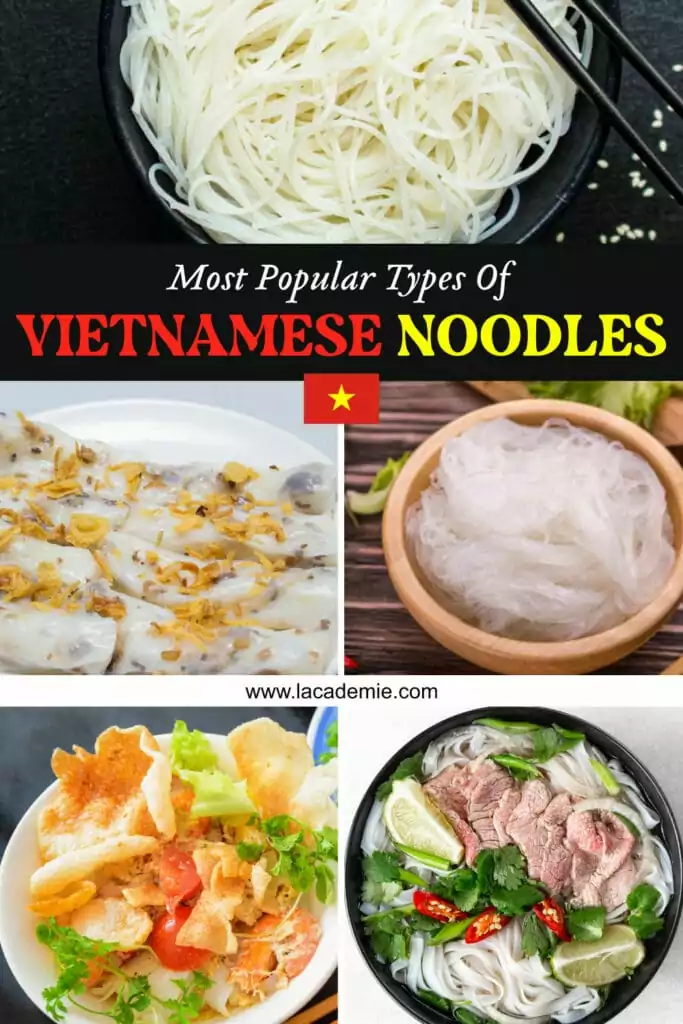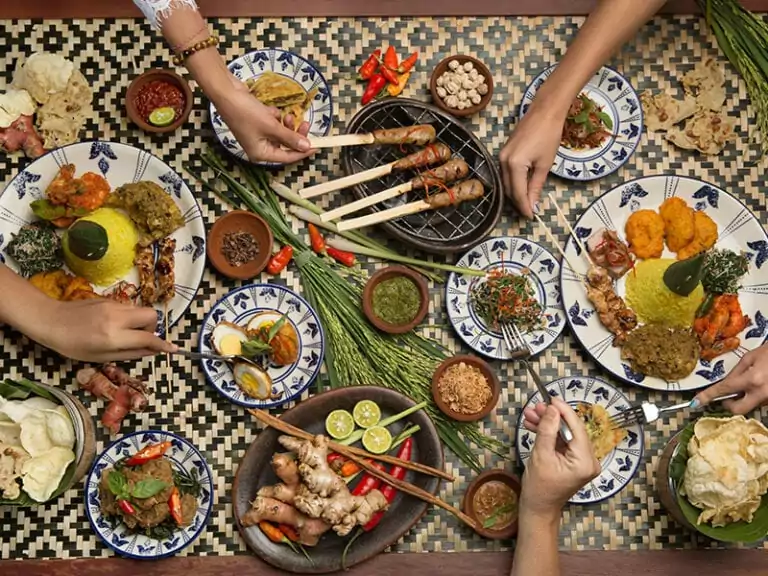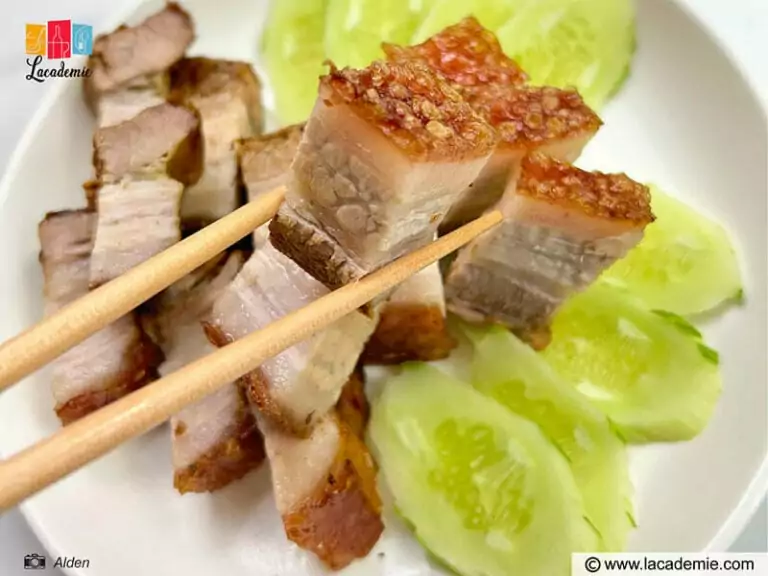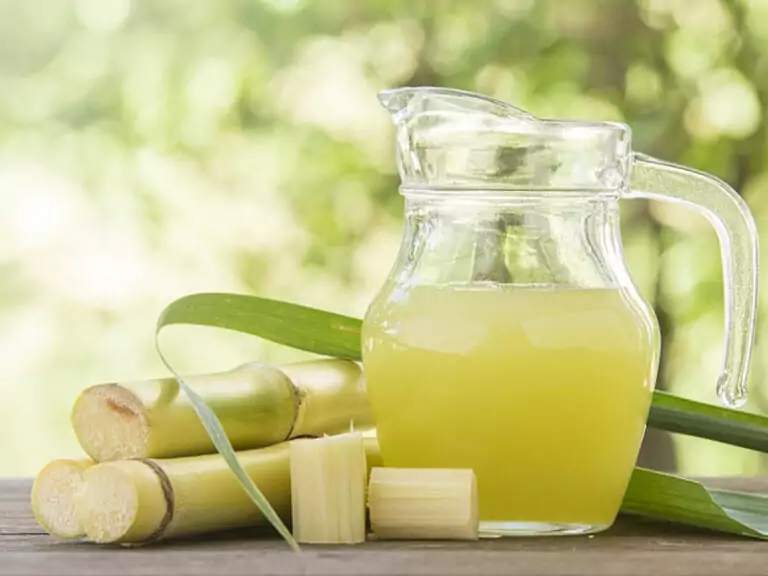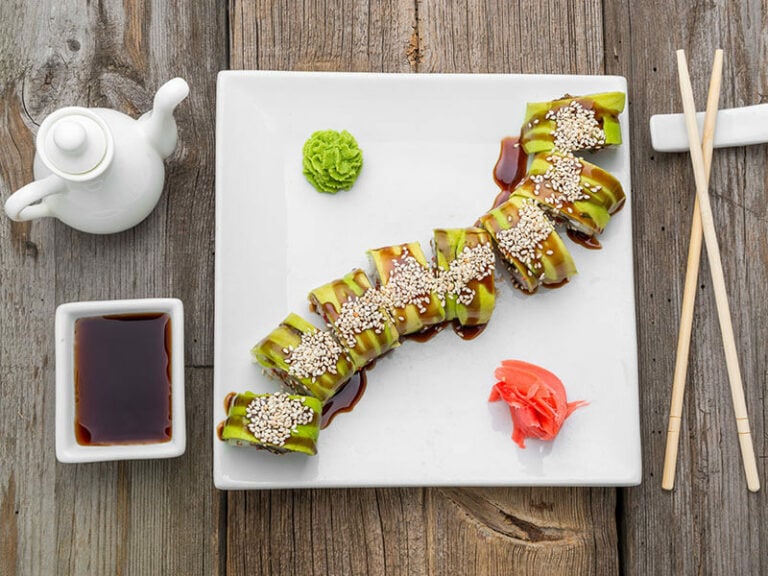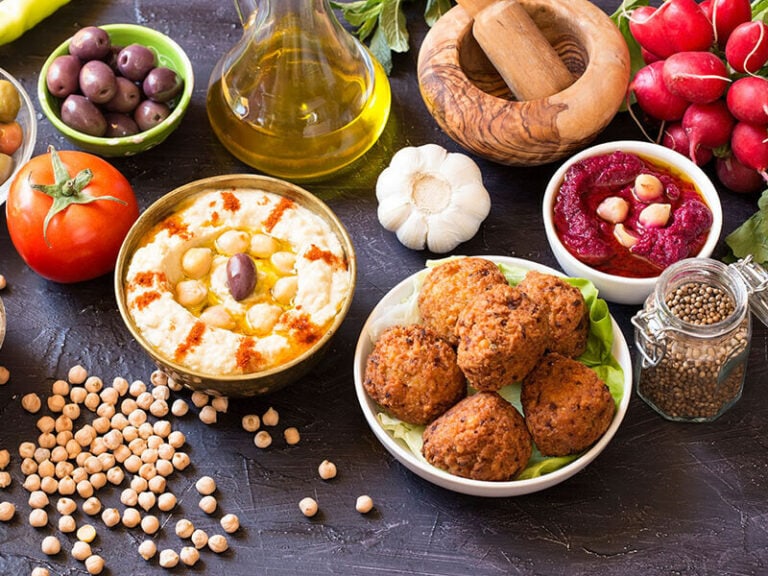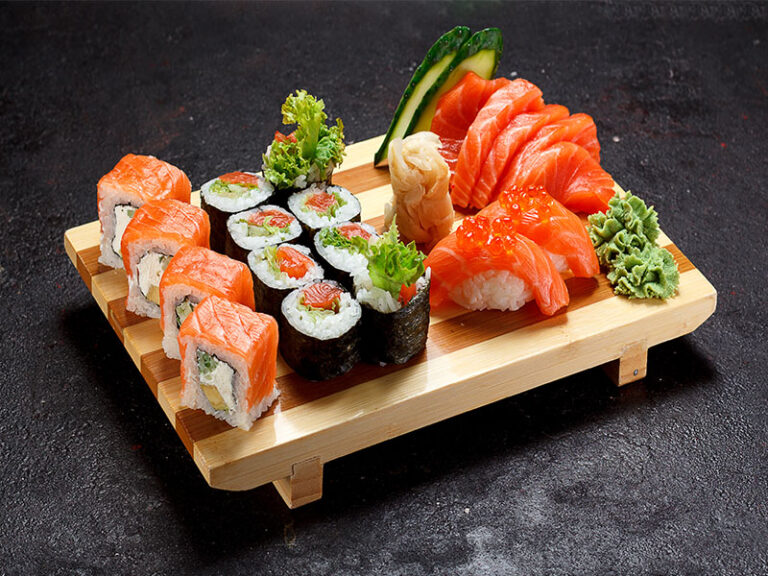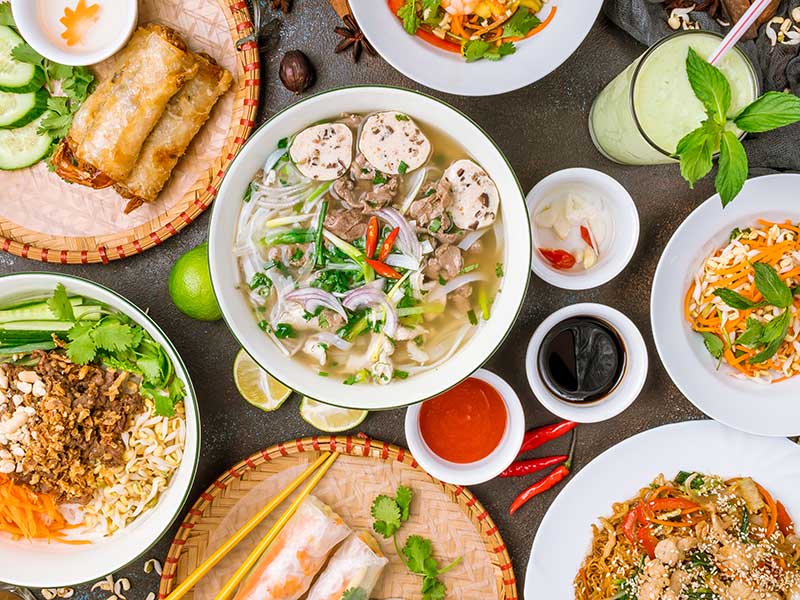
There are various types of Vietnamese noodles. They come in different colors and textures since these noodles are made of unalike ingredients. And some of them might be hard for you, as a foreigner, to distinguish.
After years of making and eating them, I have gained a lot of information about their characteristics as well as the best way to serve them. And I am about to share it with you here in the shortest yet most comprehensive way.
Besides discussing noodles, I will also introduce several famous noodle dishes in Vietnam that received tons of love from many diners. So let’s prepare some notes to list down these Vietnamese signature foods with noodles so you can try them when you come to this country.
It’s Time To Discover Some Worth-Trying Types Of Noodles In Vietnam
When trying Vietnamese noodles, you will be amazed by how diverse and delicate they are. Every type of noodle has distinctive characteristics, but one thing to be sure about is they will stimulate your taste buds and offer you an entirely new culinary experience.
Moreover, Vietnamese dishes are something that you cannot capture their uniqueness in a few tries, especially when it comes to Vietnamese noodles. Now, let’s have a quick look at these noodle varieties with the below table for some brief information.
1. Bún (Rice Vermicelli)
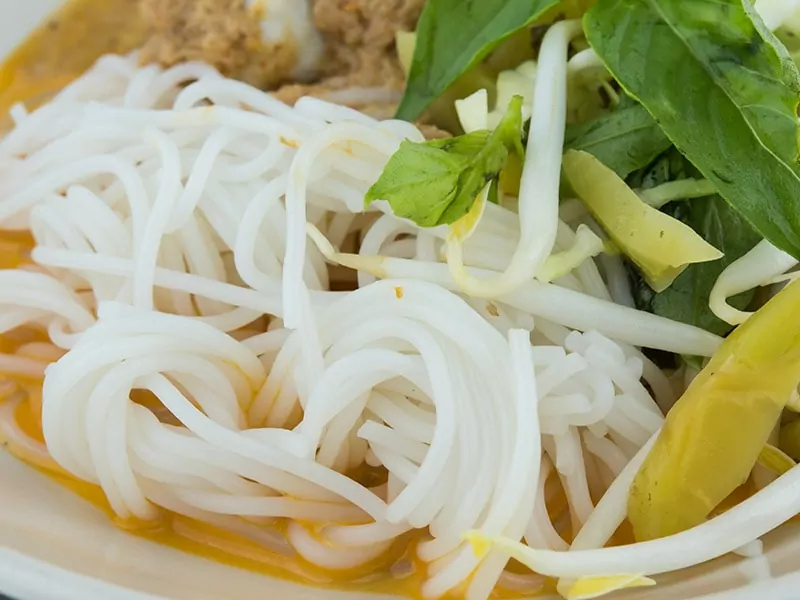
Bún (or rice vermicelli) is the most common Vietnamese noodle type. Its other names are rice sticks or rice noodles to highlight the difference between bún and cellophane noodles, which I will explain below.
This noodle kind features thin or thick round strands with typical white color. The thick version can be as thick as chopsticks. Bún’s ingredients vary, such as rice flour (common), tapioca flour, wheat, etc.
Bún is soft, sticky, and slippery. They are super versatile, making bún the most popular Vietnamese noodle type. Vietnamese normally serve it in hot soup or in dry noodle dishes. Plus, the method of bún preparation varies from region to region and from family to family.
Bún appears in plenty of popular vermicelli noodle recipes from Vietnam, such as Bún Riêu (crab noodle soup), Bún Bò Huế (spicy beef noodle soup), Bún Chả (grilled pork and noodle). The Vietnamese also use it to make delicious roll dishes, such as Gỏi Cuốn (Vietnamese fresh spring rolls), etc.
Locals also shape bún into the square and thick cakes to make Bún Đậu Mắm Tôm (noodle and tofu with shrimp sauce).
2. Mì (Egg or Wheat Flour Noodle)
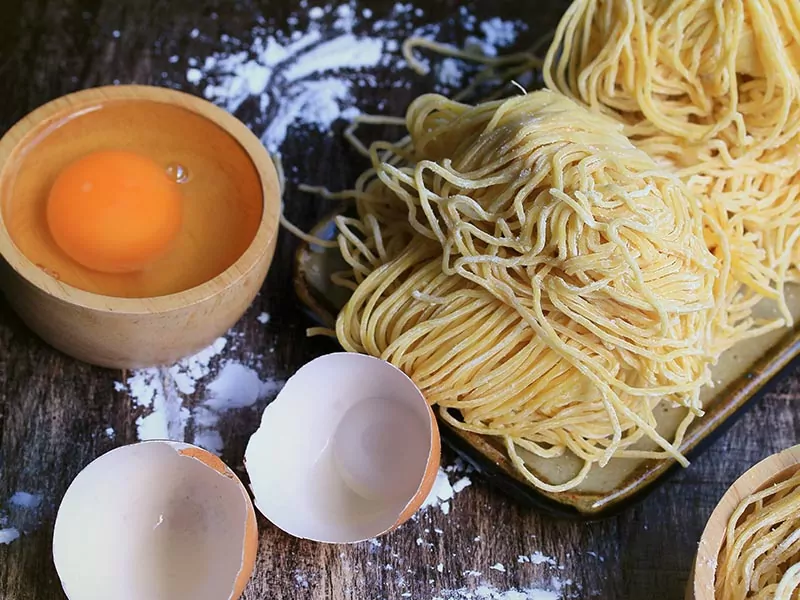
Another widely-used Vietnamese noodle is mì which refers to white or yellow noodles made from egg or wheat flour. They have a springy yet tender texture. If you have tried a special Chinese dish – wonton noodles, you can imagine how Vietnamese egg noodles look.
Therefore, they can be served in soups, especially in Mì Hoành Thánh – a Vietnamese wonton noodle inspired by the Chinese version. Mì is also ideal to pair with pork broth and other ingredients.
Other than that, Vietnamese use mì to create a wide array of fried or stir-fried delicacies (usually referred to as dry noodle dishes). In general, mì can pair well with meat, veggies, and many other components.
Common condiments to serve with mì are soy sauce, vinegar, pickled chili, or sa tế – a spicy sauce.
3. Miến (Cellophane Noodle or Glass Noodle)
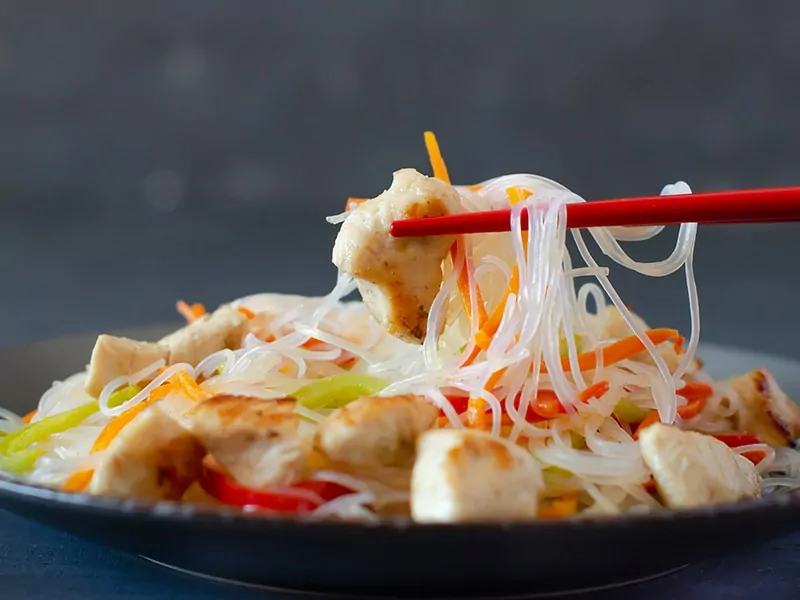
It is easy to understand why many foreigners mistake this miến with bún. Let me tell you how to differentiate them.
First, Vietnamese cellophane noodles have 2 styles. One is a Chinese-inspired noodle kind named bún tàu (made of mung bean flour), and another is miến/miến dong made from canna. Miến (aka glass noodles) is a more common-used ingredient in famous Vietnamese dishes.
Though miến shares the same sticky, chewy texture with round and thin strands as bún, this ingredient is created from water and starch (e.g., mung bean flour, potato/sweet potato flour, canna, or tapioca starch).
If you look at them closer, you can easily recognize miến’s light gray yet transparentness, and they are a bit thinner than white bún. Now you might know why people refer to this type as glass noodles.
Moreover, they are quite slippery, which might be challenging for you to eat with chopsticks. But do not fret; many dishes containing miến are totally worth trying. Miến with chicken soup (Miến Gà) or in fried foods is super tasty.
For more information, miến is normally available in dried form, requiring a quick soak before cooking.
4. Bánh Phở (Rice Stick)
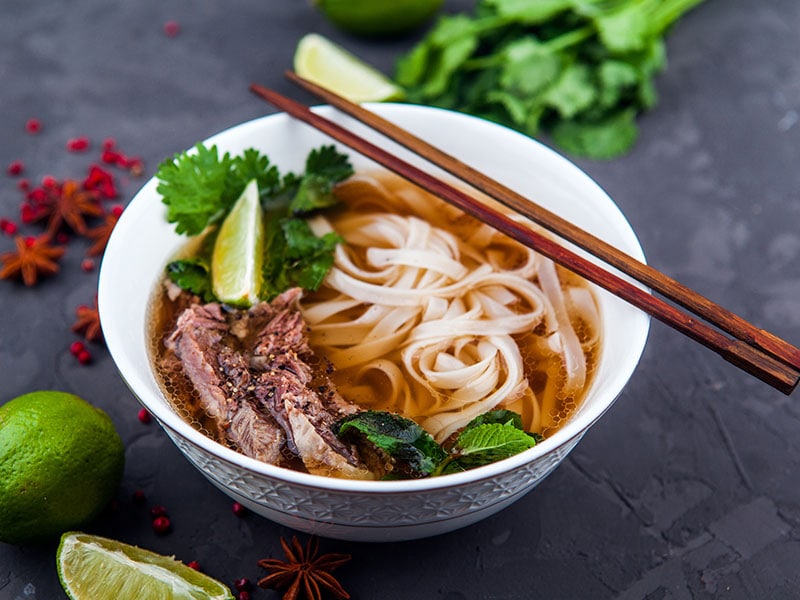
If you like Vietnamese cuisine, you have probably heard of or tried Phở (Vietnamese beef noodle soup or chicken Pho noodle soup) before since this is the most famous specialty in this country.
The noodle used in Phở is bánh phở (rice sticks). This noodle mainly consists of rice flour with a typical white color like bún. However, rice sticks have a flat shape, making them different from bún.
This noodle is soft, slippery, and quite chewy. Bánh phở’s widths vary, available in both dried and fresh versions. In addition, rice sticks are not as versatile as rice vermicelli because the Vietnamese primarily use them to make Phở.
These white sheets are also common in a stir-fried dish called Phở Xào (stirred pho), or Phở Cuốn (rolled pho), which is more famous in Northern Vietnamese cuisine.
Here is a quick review showing you how to cook flat rice sticks correctly.
5. Hủ Tiếu (Clear, Thick, and Chewy Noodles)
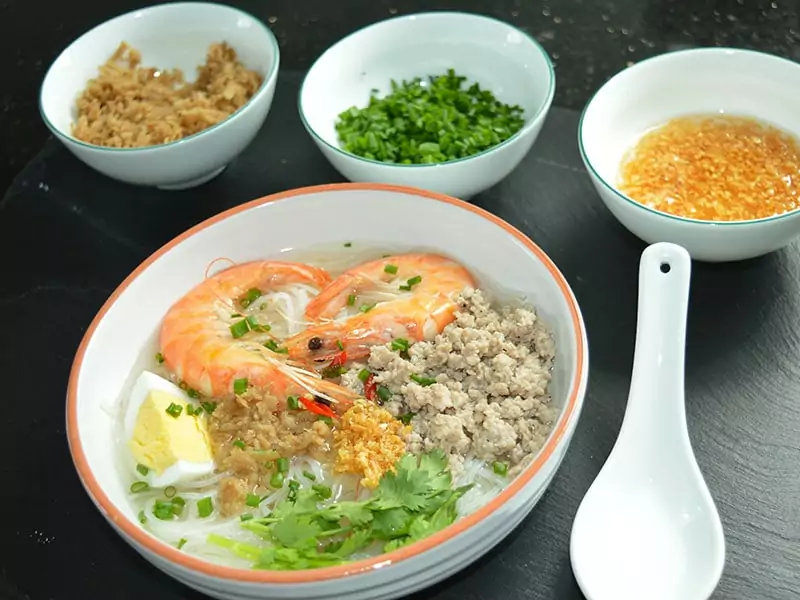
Hủ tiếu is also a very versatile variety of Vietnamese noodles. Overall, it is a very thin noodle, making them the smallest Vietnamese noodle compared to other kinds. Similar to miến (glass noodle), hủ tiếu also has a translucent look with a chewy texture.
However, its color is not as gray as miến. Instead, they are white rice noodles. Hủ tiếu’s root is from Cambodian cuisine and has become more popular thanks to Chinese vendors. In Vietnam, this food itself is also the name of a well-loved delicacy.
Let’s talk a bit about this noodle’s popularity in Vietnam. In fact, hủ tiếu is more prominent in Southern Vietnam, particularly in Sai Gon (Ho Chi Minh city). The folks normally consume hủ tiếu for their breakfasts, but they are also suitable to enjoy at any time of the day.
These clear rice noodles might be served with or without soup. Other widely-used ingredients in hủ tiếu are pork, shrimp, squid, herbs, etc. There are also many hủ tiếu varieties, and the most famous one must be Hủ Tiếu Nam Vang (shrimp and pork chop noodle soup).
Hủ tiếu? How to pronounce it, and what is it? This video will show you the correct way to say it by the natives.
6. Mì Quảng (Quang-style Noodle)
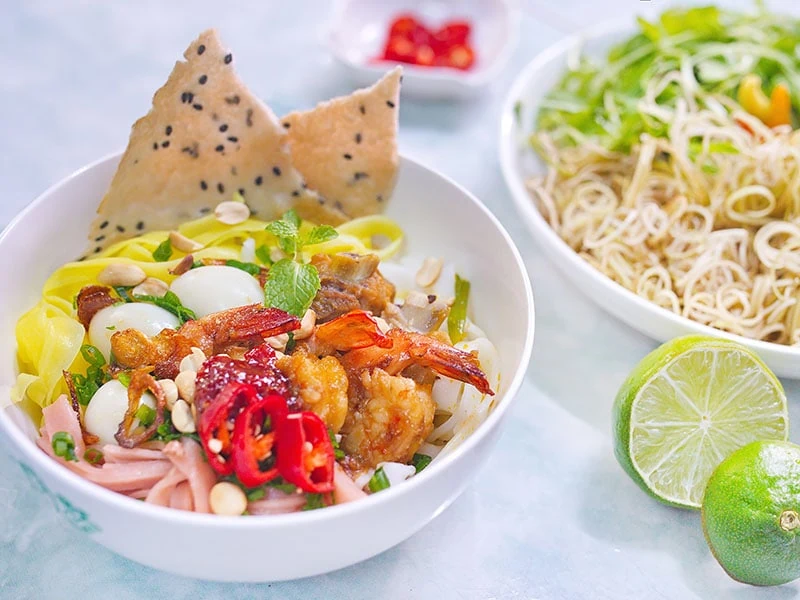
Rice flour is the main ingredient in making mì Quảng strands, but this noodle style is noticeably thicker than other noodles.
Quang noodles come in different variations with different colors. They could be yellow (as it includes turmeric), white (made from normal white rice), and brown-red (composed of brown rice).
The way to make this noodle type is similar to bánh phở (rice sticks). People soak rice in water first, then ground the grains and shape them into smooth, flat rice sheets. The final process is cutting them into thick strands.
That’s why many people claim Quang noodles are pretty similar to rice sticks. However, this noodle style is chewier due to other added substances in the ingredient.
In this country, the locals also use it to make a dish with the same name. It is a specialty of Quang Nam province in the center of the country. For more information about this super hearty dish, please do not skip the rest of this article.
7. Bánh Canh (Noodle Made From Tapioca Flour Or Tapioca Mixed Rice Flour)
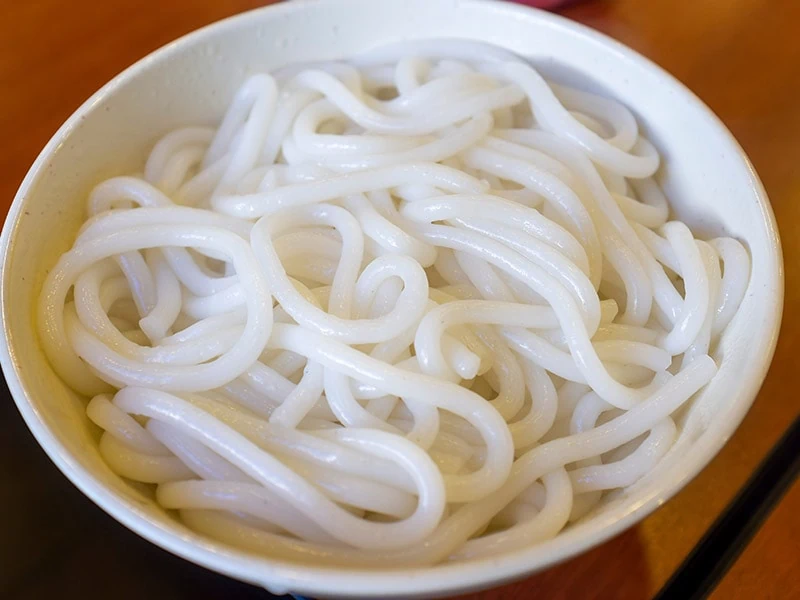
If you’ve tasted a Vietnamese delicacy called Bánh Canh Cá Lóc before, I’m sure you’re impressed with the noodles used in this dish. Bánh canh is different from the rest because of its exceptionally big, thick, and round shape with slippery and extra soft texture. The main components to make this Vietnamese-style noodle are a combination of rice and tapioca flour or tapioca flour.
They quite resemble Udon noodles – a variety of Japanese noodles. Both have a thick and chewy texture. However, their ingredients are completely different. Udon consists of wheat flour rather than rice flour.
These noodles might have opalescent white or translucent color. The chewier and more translucent version of bánh canh is bánh canh bột lọc made from filtered tapioca flour.
Like other Vietnamese-base noodles, bánh canh also refers to Vietnamese dishes, including Banh Canh Gio Heo (thick noodle soup with pork) Bánh Canh Cua (crab tapioca noodle soup), Bánh Canh Chả Cá (with fish cakes), and more.
8. Bánh Đa (Vietnamese Red Noodle)
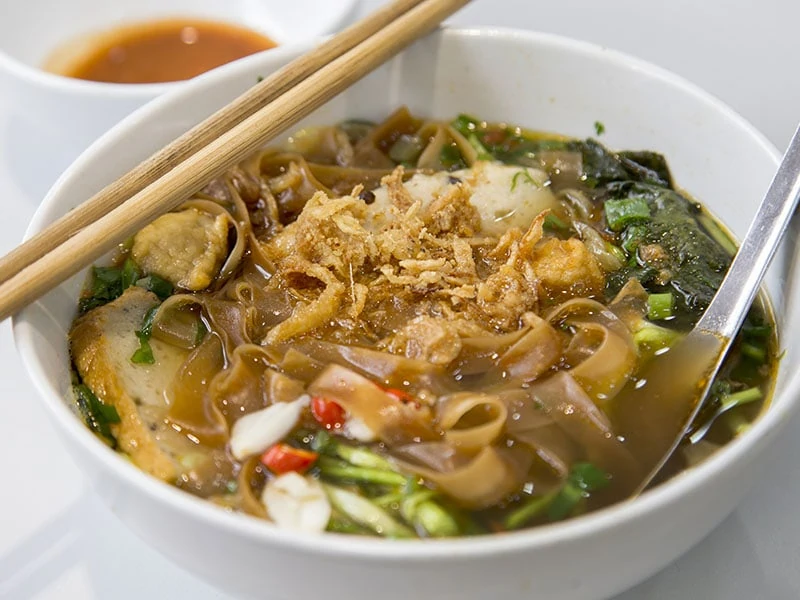
It is interesting how the natives use the word “bánh” to indicate many noodle varieties. As I know, it might not be too easy for you to remember the local name of these foods. But with this type, you can acknowledge them quicker with their red and transparent hue.
Though it is made from high-quality rice, bánh đa is easier to tell apart from other Vietnamese noodles by its color. These sheets are flat with a wide width.
Bánh đa features a soft and chewy texture. Making bánh đa also requires carefulness with great attention to soaking rice time and temperature.
The folks mainly use these noodles in Bánh Đa Cua (red noodle soup with crab). This is a highlighted treat in Hai Phong – a province in the northeastern region of Vietnam that I will also tell you more about in the upcoming part.
9. Bánh Cuốn/ Bánh Ướt (Steamed Broad Noodle Sheet)
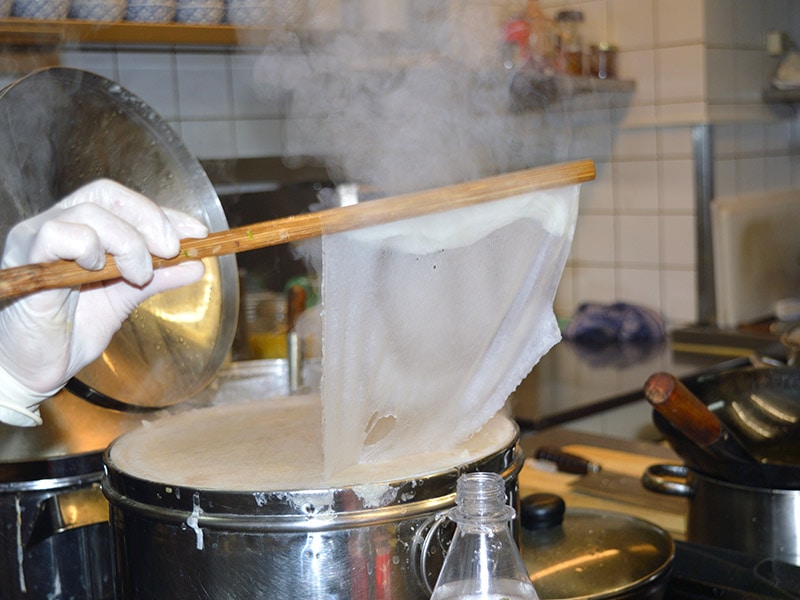
The next one is bánh cuốn (or bánh ướt). This type of noodle totally stands out compared to others since they are wide sheets of noodles with a white hue. These rice sheets are made of fermented rice batter with an extremely thin texture, making them so easy to tear apart.
To make this food, you need a special tool with a stretched cloth spread over a boiling-water pot. Then you will pour the rice flour mixture on this cloth, then cover it with a lid so the boiling water can steam your food.
For your information, Bánh Cuốn is also the name of a Northern specialty which includes wide sheets and cooked ground pork, shallot, and wood ear mushroom filling. It is also well-liked Vietnamese street food that you can get at an affordable price.
If there is no filling, it is Bánh Ướt. However, you can find Bánh Ướt easier in Southern Vietnam.
Click here to explore more about bánh ướt. You will be surprised by how skillful a vendor is.
10. Bánh Tằm (Thick and Short Rice Noodle)
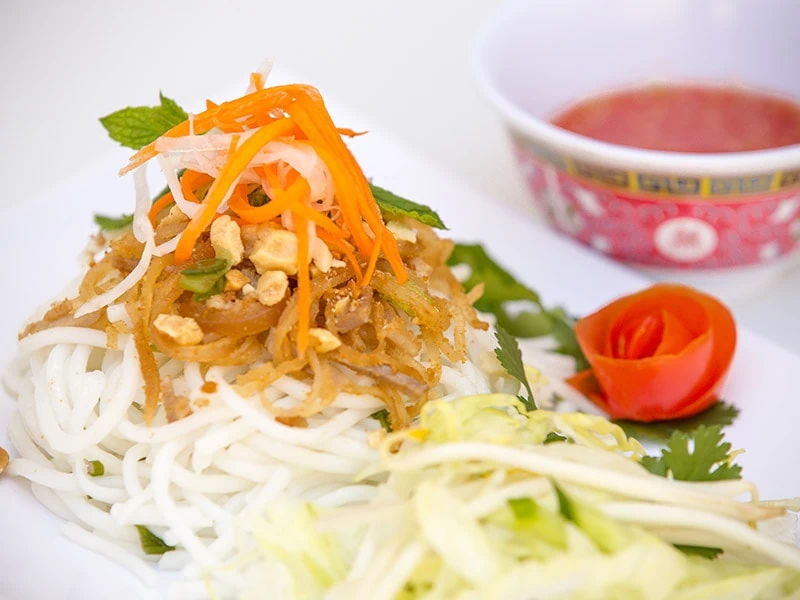
Obviously, the primary component to make bánh tằm strands is rice flour. In reality, Vietnamese can make them with other ingredients like glutinous rice flour or tapioca flour. They are also thick, soft, and quite chewy with an opalescent white hue like other noodle styles.
Tằm strand’s flavors are different by region because each place has distinctive ways of mixing the flour. Moreover, the important part of making bánh tằm is stirring the flour mixture to ensure they will not come out breakable or too sticky.
However, there are not too many Vietnamese noodle dishes that use bánh tằm. The most famous one must be Bánh Tằm Bì (Vietnamese-style noodle with coconut cream). And it is only famous in the Southern part, especially in Bac Lieu province in the Mekong Delta of Vietnam.
No one can be sure about the origin of this food. But here is an interesting story about this noodle variety. In Vietnamese, “tằm” means silkworm, which implies the white, thick, and short appearance of this noodle.
11. Bánh Hỏi (Strings Of Noodles)
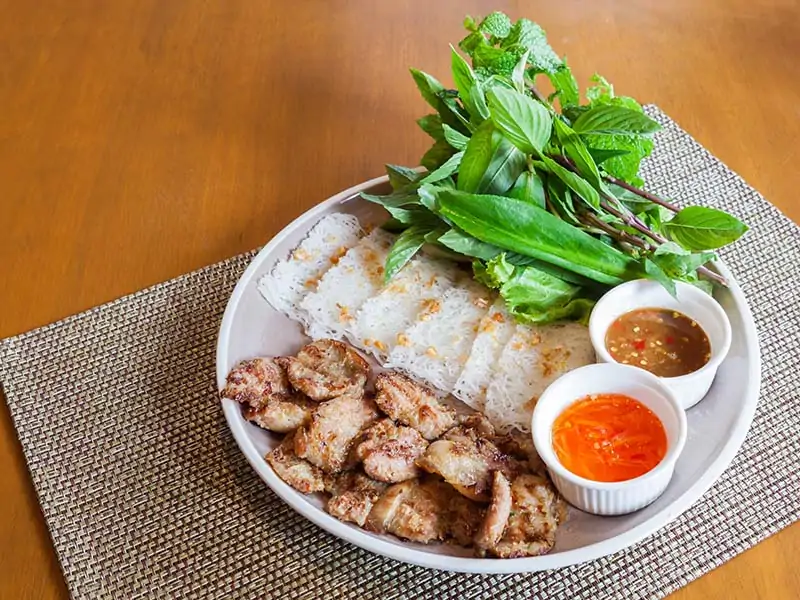
Bánh hỏi are very thin strands shaped into sheets and woven. How thin are they? Well, you can imagine bánh hỏi as thin as toothpicks, but they are not easy to tear apart because this noodle variety comes in bundles.
People make it from rice, just like rice vermicelli. Nevertheless, the process of making them is not simple to try at home. It contains many steps, including soaking rice, grinding them, steaming and kneading (or cooking by a pan) the flour mixture.
All together to create a light yet firm bánh hỏi without any stickiness. This type of noodle derives from Binh Dinh – a South Central Coast province in the country.
Vietnamese people love to serve bánh hỏi with meat such as beef and pork. They often sprinkle some spring onion oil on the top.
12. Nui (Vietnamese-style Macaroni)
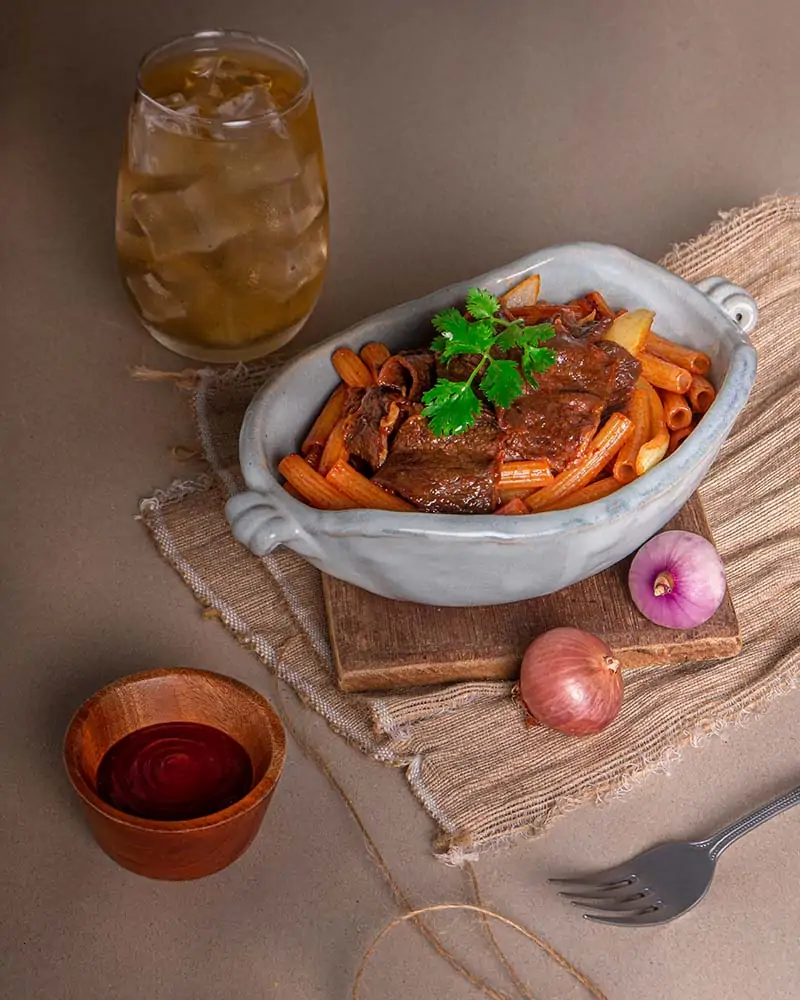
Nui is the last special and easy-to-recognize type of noodle. The term “nui” also comes from the French word “nouille”, which literally means noodle. Overall, this is a thick noodle with various shapes.
They normally come in small sizes with appearances like stars, penne, macaroni, fusilli, and rigatoni pasta in white or pale yellow. Nui is normally sold in dried form that you can easily buy in any Vietnamese grocery, market, or supermarket.
What makes up nui are normally wheat flour, rice flour, water, and other substances. Regarding enjoying this food, you can serve it with hot soup, including various types of meat, seafood, and veggies. Or stir-fried nui with beef is also a delicious meal that many Vietnameses love.
Your kid will surely love this nui soup.
10+ Super Tasty Vietnamese Noodle Dishes You Do Not Want To Miss
Knowing the types of noodles is not enough. Vietnam also has many delicate noodle dishes that you may have never tried. Let me give you some essential information about the signature delicacies in 2 separate groups: Hot/Warm noodle soups and Dry noodle dishes.
How Many Hot/Warm Vietnamese Noodle Soups Have You Tried Before?
First, check the table below for the shortest insights regarding these Vietnamese foods served with hot soups. Moreover, they are fantastic choices for winter dinners. Now, let’s take notes to ensure you will not miss any dish on your upcoming trip to this wonderful Asian country.
1. Phở (Beef Noodle Soup)
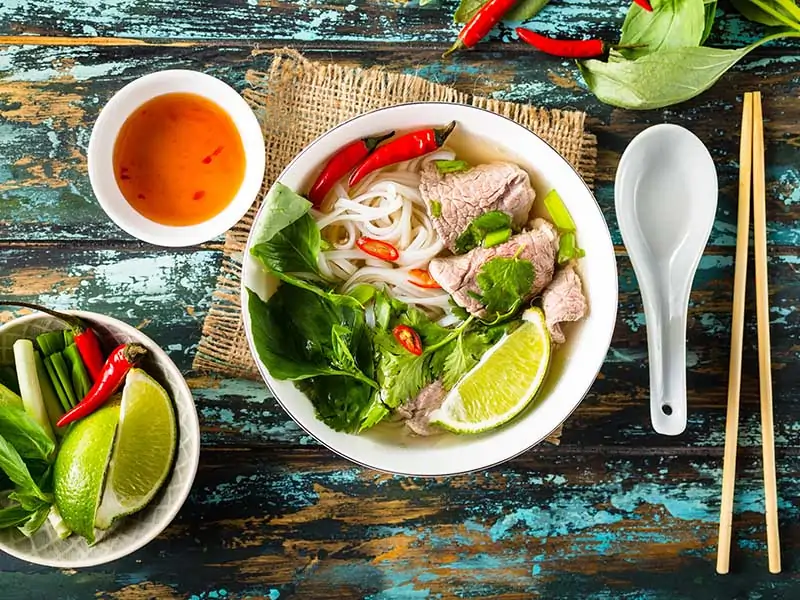
Speaking of authentic Vietnamese foods, everybody will think of Phở. It is one of the national dishes of Vietnam. It features bánh phở with a beef broth. And below are some additional interesting information about Phở.
The broth’s deliciousness is created by cooked beef leg or oxtail with ginger, onion, and spices (e.g., star anise). Some people order extra-fatty broth to make the soup richer and sweeter.
The toppings for this comforting soup can be thinly sliced beef, flank cut, beef meatballs, and tendons. In Northern Vietnam, the locals often dip the toppings in a sauce before eating them.
There are various vegetables and herbs served with Phở, such as mint leaves, lime, Thai basil, sawtooth, scallions, and bean sprouts. Moreover, some people also love to consume it with poached eggs in a separate bowl.
Phở has several varieties based on the regions. And not all Phở dishes consist of beef. You can also find chicken, seafood, or vegetarian Phở here.
Making Pho is easier than you think. Give this recipe a try!
2. Cao Lầu (Hoi An Noodle Soup)
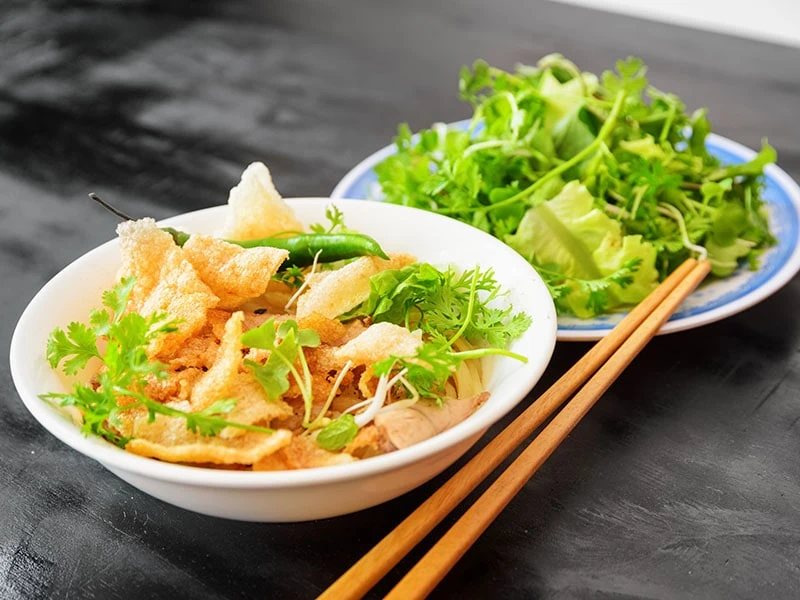
If you come to the ancient city of Hoi An in Quang Nam province, you must try Cao Lầu. It is different from other types of noodles in the way it is served.
Rice is the main component in making Cao Lầu noodle strands. However, people soak the rice in lye water before transforming it into noodles. This results in a deliciously springy and chewy texture.
People make broth from pork bones, shallots, and onions. They top the soup with marinated pork and serve it alongside vegetables such as perilla, mint, lemon basil, cilantro, lettuce, and bean sprouts.
Another topping is deep-fried noodles. The chefs will cut the noodles into small pieces, and deep fry them until crispy. Unlike other Vietnamese noodles, Cao Lầu is rarer since you can mostly find it in Hoi An.
3. Bún Bò Huế (Vietnamese-style Spicy Beef Noodle Soup)
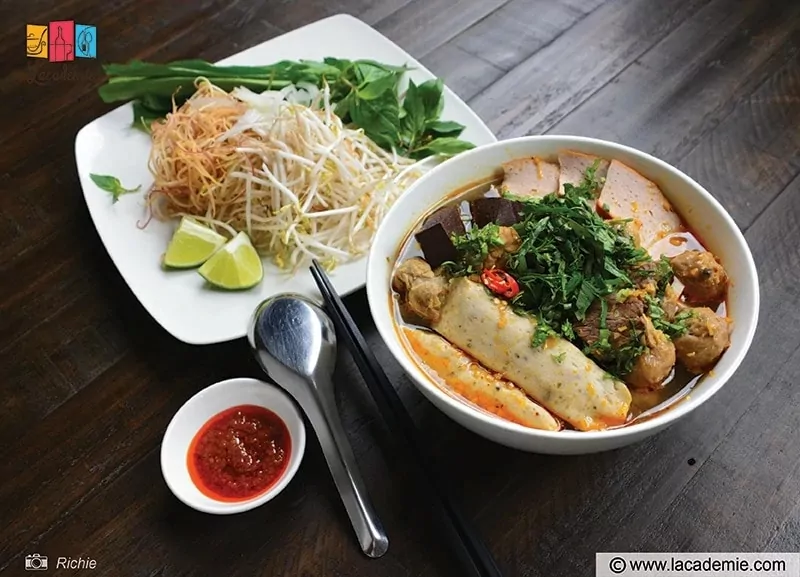
Bún Bò Huế is a specialty of Hue, a city in the center of Vietnam. Like Phở, it contains beef broth, but its flavor is completely different. It is rich, umami, salty and spicy. It is bold and has a stronger taste than Phở. The noodle used in this soup is thick bún.
Traditionally, people make broth with beef shank, beef bones, lemongrass, fermented shrimp sauce, and spicy chili oil. Regarding the toppings, accompanying it with pig’s knuckles, beef shank, and chunks of oxtail are the best ones.
Bún Bò always has tons of vegetables and herbs come along, namely cilantro, green onions, thinly sliced onion, sawtooth herbs, and mung bean sprouts. If you want it to be stronger in taste, you can add shrimp paste or fish sauce.
Try creating the classic bold flavor of Bun Bo Hue!
4. Miến Gà (Glass Noodle Soup With Chicken)
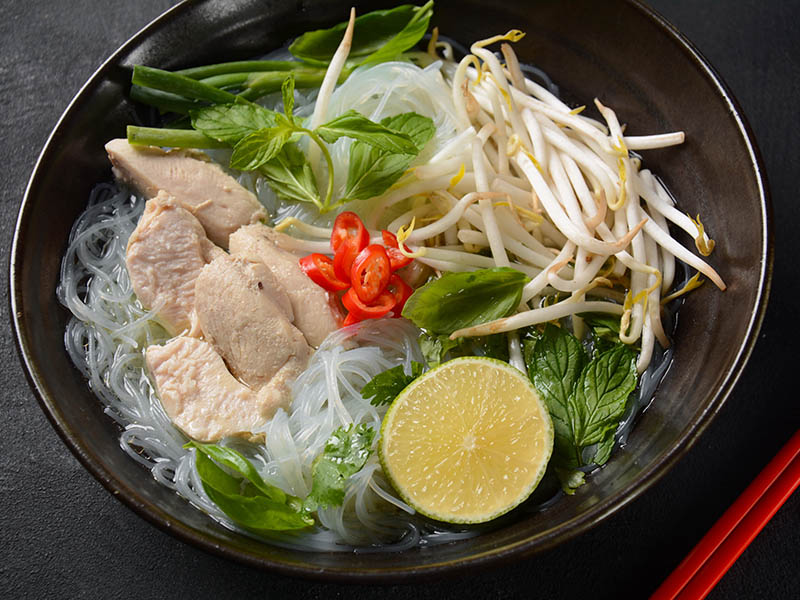
If you do not like bold and strong noodle dishes, I think Miến Gà (chicken with glass noodles) will please your taste buds. It has a light and savory flavor.
The locals made it from chicken broth and some simple seasonings such as ginger, fish sauce, and black peppers. It is super healthy and tasty with chicken, onions, scallions, and some pepper flakes.
Nowadays, Vietnamese people serve it on important occasions like New Year’s Eve and the anniversary of a funeral.
5. Bún Riêu (Crab Noodle Soup)
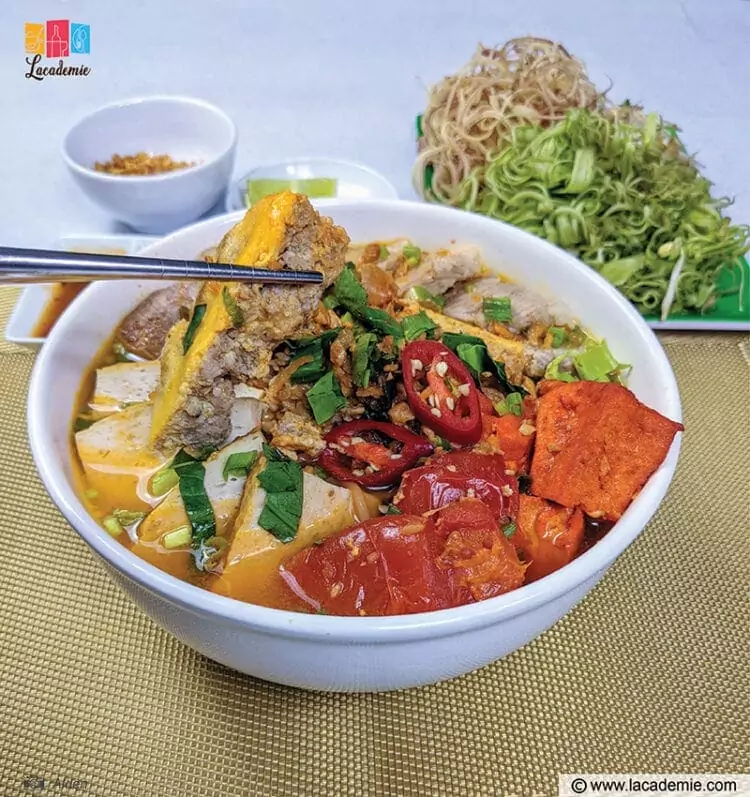
You can find Bún Riêu in every Vietnamese restaurant in Vietnam. It has a distinctive light sour taste that is hard to find in other dishes. Bun Rieu consists of tomato, tofu, shrimp paste, and thin rice vermicelli.
The main stars of Bún Riêu are crabs, fish, and snails. People clean the crabs and then turn them into a paste before adding them to the soup. For the best pleasant meal, enjoy it with plenty of vegetables like perilla, water spinach bean sprouts, or sliced banana flowers.
This traditional Bun Rieu recipe is not only delicious but also heart-warming.
6. Mì Quảng (Quang-Style Noodle Soup)
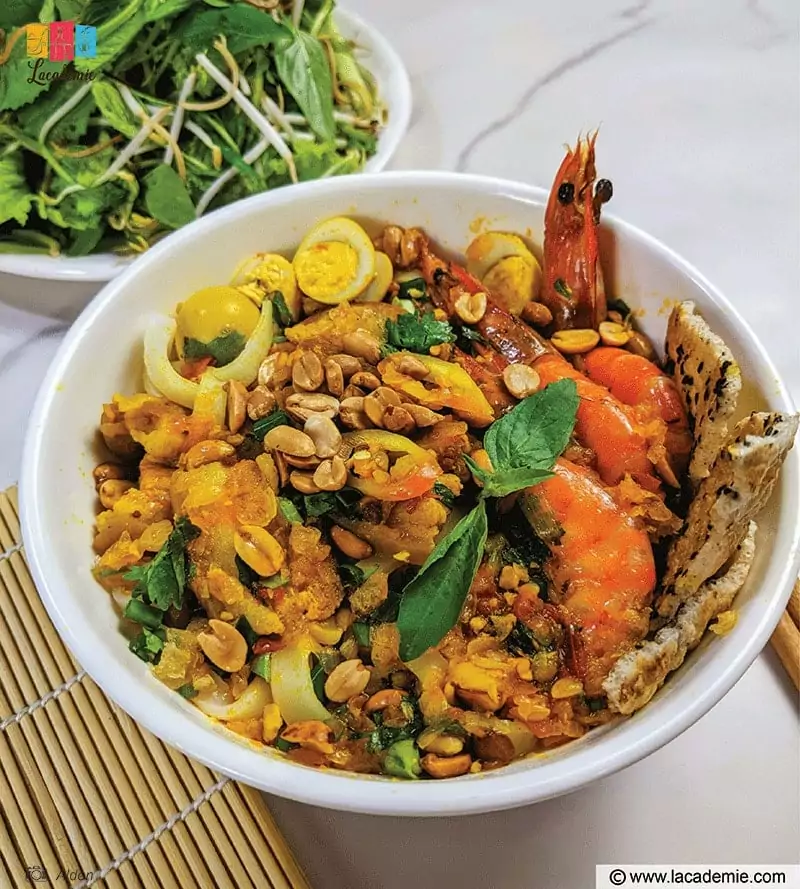
Mì Quảng is a best-loved Quang Nam dish but you can find it at various street food stalls and restaurants across Vietnam.
The broth of Mì Quảng comprises turmeric, meat, and other ingredients. It is often very bold and strong. Plus, when serving, the locals do not let the broth cover the noodles completely.
The topping for this treat can be chicken, shrimp, pork, fish, beef, boiled quail eggs, or steamed pork sausage (chả). Plus, toasted sesame rice crackers (bánh tráng mè) are another special addition to increase the nutty taste and crunchy texture of the dish.
If you want to make this soup more flavorful, please add garlic, fish sauce, and black pepper. Additionally, vegetables and nuts are must-have ingredients in Mi Quang like peanuts, water mint, lettuce, scallion, cilantro, and common knotgrass.
If you seek a delicious Vietnamese-style breakfast, consider this Mì Quảng.
7. Bánh Canh (Thick Noodle Soup)
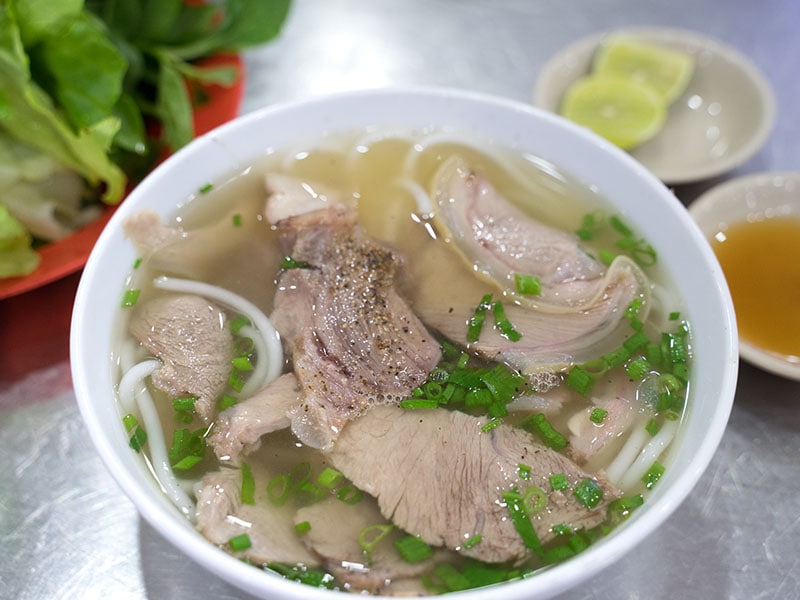
Bánh Canh refers to a noodle kind and a noodle dish as well. This dish is special because there is no fixed way of preparation. The recipe varies from region to region and from family to family.
Bánh Canh Cua is the first style that I want to introduce that consists of crab soup and quail eggs. Bánh Canh Giò Heo Tôm Thịt has shrimp and pork knuckle, or Bánh Canh Chả Cá includes fish cake.
Another famous regional version is Bánh Canh Trảng Bàng, which indicates the origin of this delectable dish (from Trang Bang town). People top it with boiled pork and some types of local herbs. And all versions come with scallions, cilantro, black peppers, and red pepper flakes.
8. Hủ Tiếu Nam Vang (Shrimp and Pork Chop Noodle Soup)
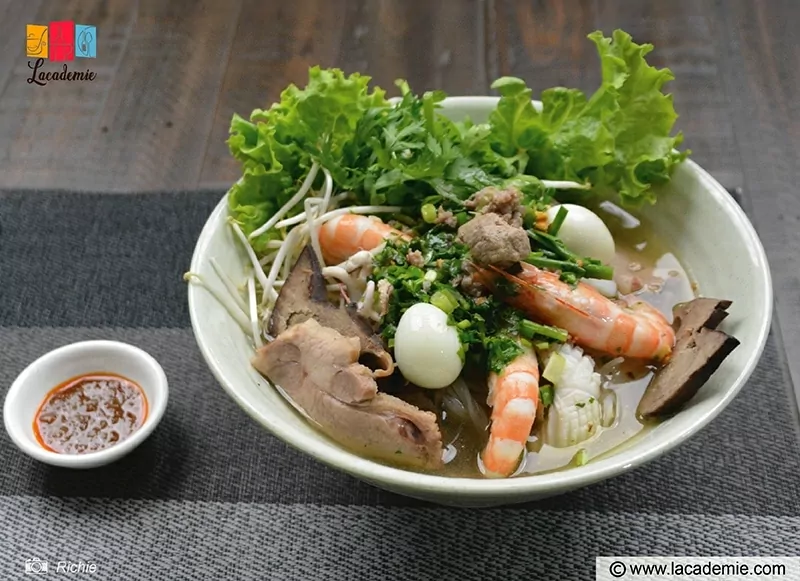
“Nam Vang” refers to the Vietnamese word for a Cambodian city – Phnom Penh. Therefore, Hủ Tiếu Nam Vang is a dish inspired by Cambodian cuisine. It uses hủ tiếu strands, as indicated in the name.
This hot soup has a rich and umami taste. The broth mainly comprises pork bones and dried shrimp. People top it with ground pork, pork loin, and sliced pork liver.
Shrimp (or prawn) and quail eggs are also people’s favorite toppings. Regarding vegetables, people use shallots, Chinese celery, Chinese chive, basil, and fried garlic.
Dry Vietnamese Noodle Dishes – Other Quintessential Foods In This Country
Vietnamese cuisine is so creative with many ways to enjoy noodles. And these dry noodle treats are the best examples that I believe you will love at the first bite.
9. Bún Chả (Grilled Pork and Noodle)
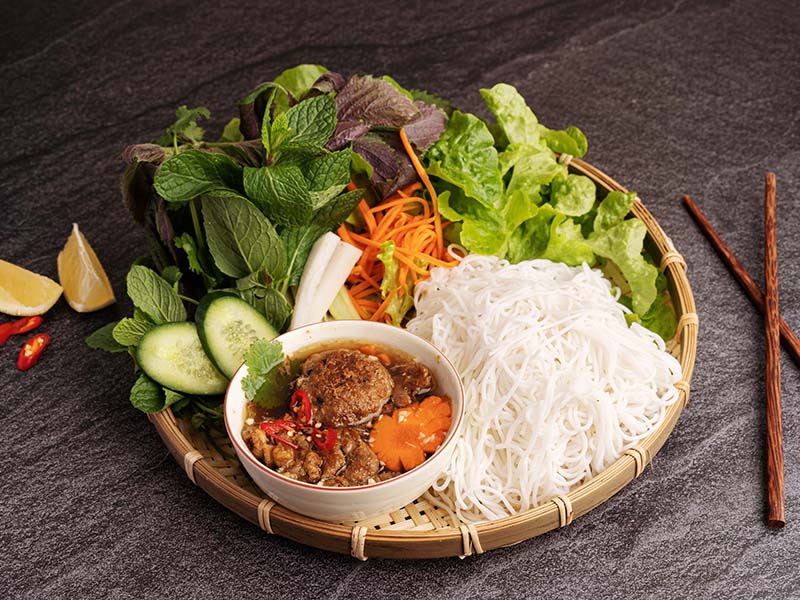
Bún Chả is the signature dish of Ha Noi, the capital city of Vietnam. While other noodle styles tend to serve noodles in the soup, Bún Chả is different. People serve noodles, sauces, and vegetables separately.
The main ingredient of this noodle dish is grilled pork patties (chả) made from the minced pork belly or pork shoulder and thin bún. And the Vietnamese normally serve it with fresh veggies, pickled vegetables, and herbs.
Moreover, a delicious sauce made with fish sauce, garlic, chili, and lemon juice is an indispensable part. Traditionally, people serve Bún Chả for lunch. But as it has become popular over time, you can enjoy it any time of the day.
Add this authentic Bun Cha recipe to your must-try list when visiting this Asian nation!
10. Bún Thịt Nướng (Grilled Pork Noodle Bowl)
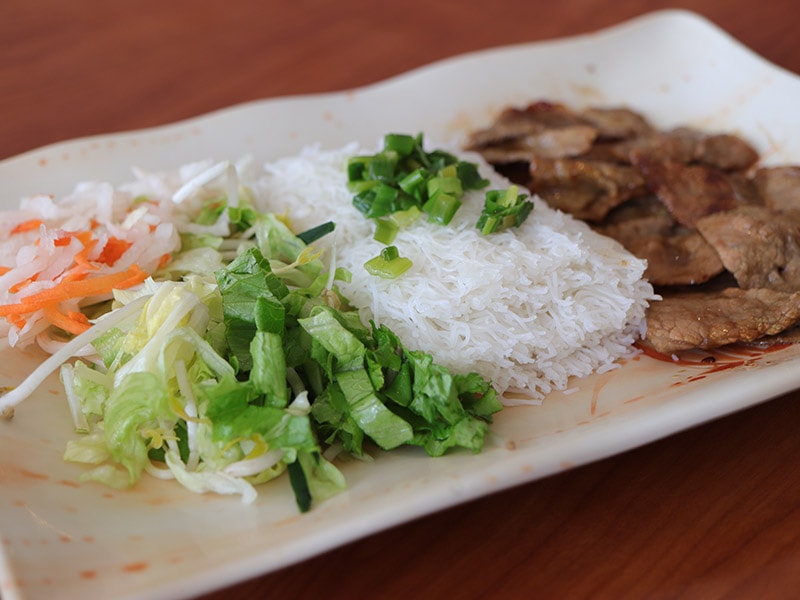
Bún Thịt Nướng features a thin bún served with marinated grilled pork, spring rolls (chả giò), grilled prawn, and grilled garlic pork sausage (nem nướng). It also includes various vegetables and herbs like salad, bean sprouts, basil, pickled carrots, and mint.
People serve everything in the same bowl with bún and everything else on top of it. Remember to drizzle fish sauce over it before eating.
This dish is a very popular breakfast dish. You can find it everywhere in Vietnam. However, it is less prevalent in Ha Noi because people there prefer Bún Chả more than this dish.
11. Gỏi Cuốn (Fresh Spring Rolls)
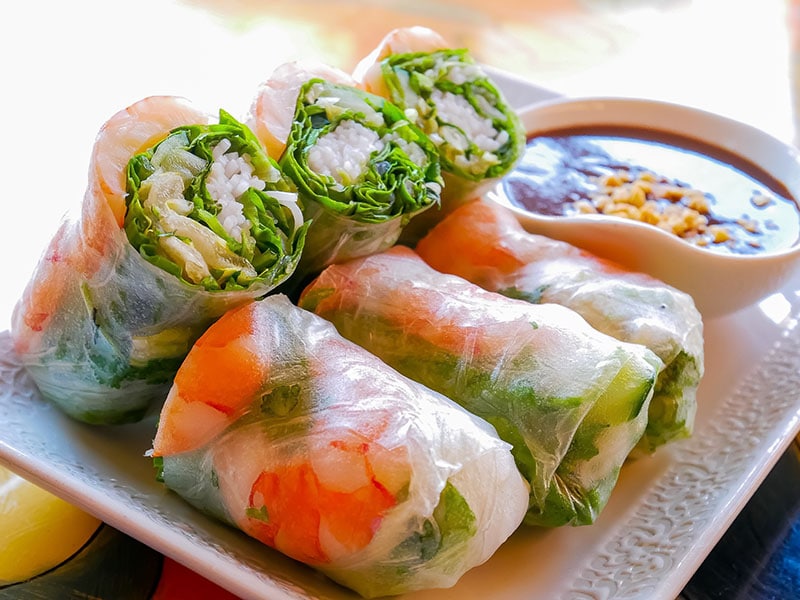
First, you need to note that though they are a type of spring roll dish, Gỏi Cuốn uses fresh ingredients and does not need a frying step like other golden spring rolls. Thin bún, pork belly, shrimp, rice paper, and greens are must-have components to make these fresh rolls.
The only cooking part that you need to do is boil the dried bún, pork belly, and shrimp, then wrap all ingredients in rice paper. If you cannot find rice paper in the supermarkets, try to find it in any Asian grocery.
Gỏi Cuốn is incomplete without the sauces. Dipping sauce made with fish sauce and peanut hoisin sauce are the 2 best options to serve with these fresh spring rolls.
Fresh Vs. Dried Noodles, Which One Is Better?
In fact, it is hard to answer this question appropriately because it depends on the type of noodles and where you can buy them. In Vietnam, many noodle styles are available in both fresh and dried forms.
You can effortlessly find fresh bún (rice vermicelli), bánh phở (rice stick), bánh canh (tapioca flour noodles), or bánh tằm (thick and short rice noodles) in many Vietnamese markets. In contrast, miến (glass noodles), bánh đa (red noodles), or nui mostly come in dried form.
It would be more challenging to buy fresh Vietnamese noodles in foreign countries. But you still can buy dried versions in Asian-style shops, then boil them for a few minutes before consuming your food. Or you can purchase noodle maker equipment to make them by yourself at home.
Vietnamese Noodles Are Abundant And Interesting!
After reading this article, have you found a Vietnamese noodle dish to try? It is not simple to choose, right? So if possible, try all of them. And I am sure that you might want to eat these noodle delicacies over and over again.
If you have friends and relatives who are also fans of Vietnamese cuisine, why not share this article with them to gain more knowledge about Vietnamese noodles? I highly appreciate your likes and shares. Thank you for your support, and see you in the next article!
